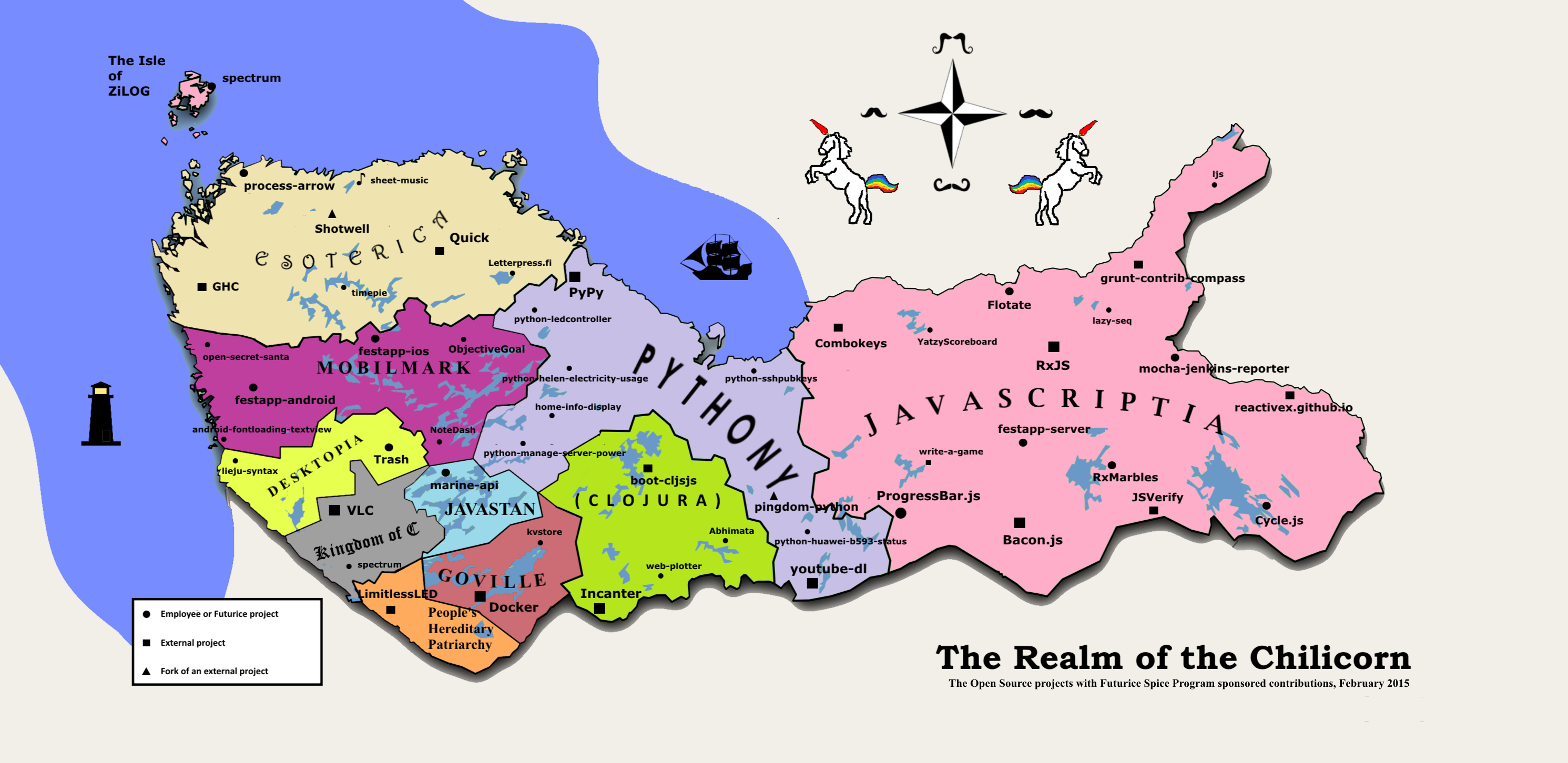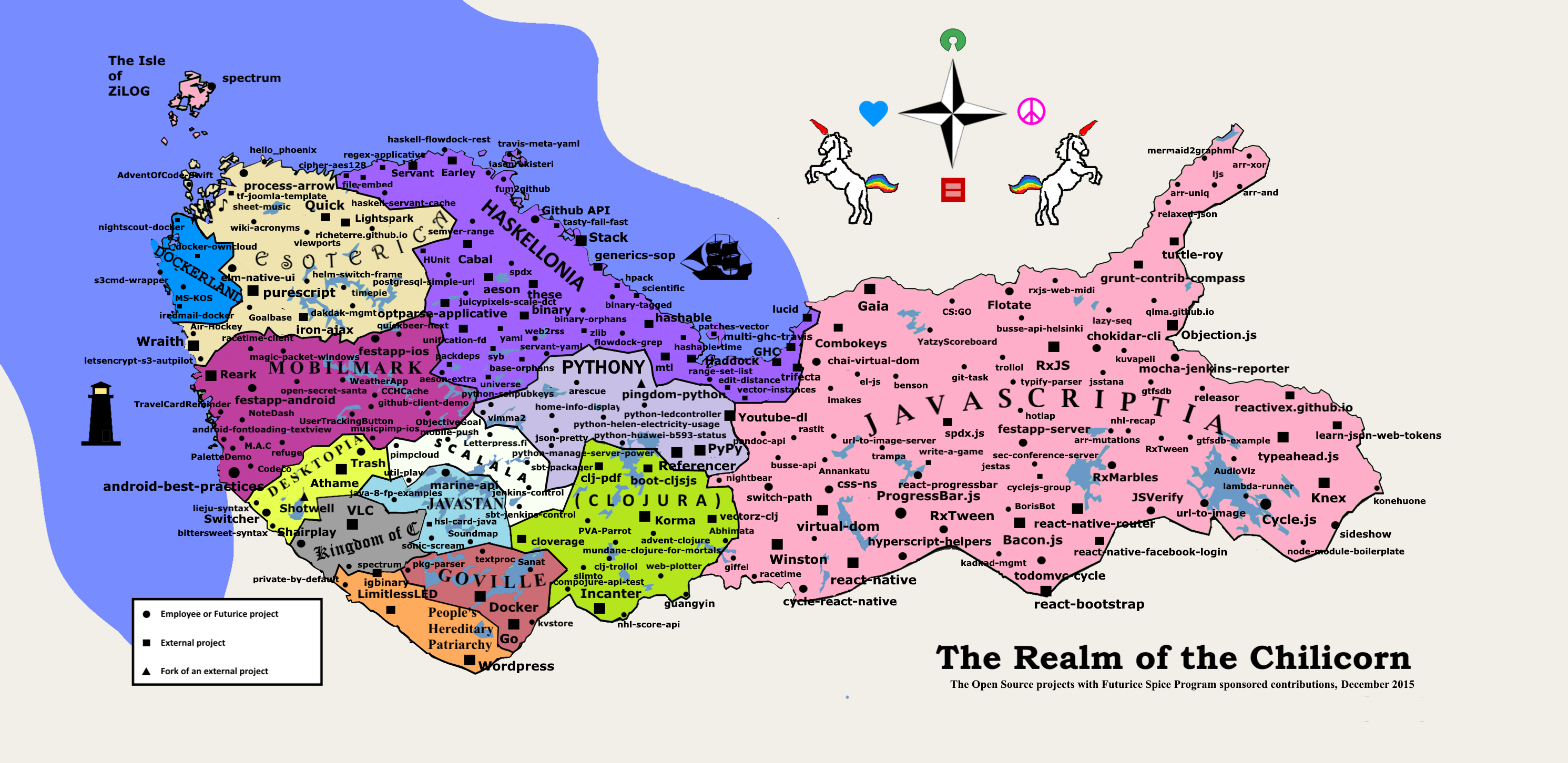Why you should pay employees for free-time Open Source contributions
Late in the year 2014 we at Futurice began to sponsor employee free time open source contributions. What has happened since? Let’s take a look at the year 2015.
UPDATE: Based on some early feedback I want to clarify that our Open Source sponsorship has nothing to do with company (or customer) owned software projects. Each employee decides what she wants to spend her time on, if anything. Mainly the sponsored hours have gone towards small internal projects, as you can see from the map visualisation below. Doesn't have to be software either; there have been hobby related blog posts, even sheet music. You can find all the minutiae in here.
Numbers
Our sponsorship model has remained the same. €15 paid per reported hour, max 30 hours monthly. Anything goes, as long as it is Open Source.
In 2015 we paid sponsorship money based on 400 reports by 60 different people, working on 150 different projects, spending a sum of 2500 reported hours. This cost the company €37500. In 2015 Futurice had about 240 employees.
Projects and technologies
After the sponsorship had been in place for 3-4 months, this being February 2015, I made a slightly humorous (or naivistic) map visualisation of the projects we had contributed to up to that point.

Each country is a (roughly defined) technology area, cities represent the projects that our people have contributed to and reported it for the sponsorship program.
Our people liked the map a lot, but despite my deep understanding of Microsoft Paint, its creation was quite a lot of work. I started to think about how to automate the updating of it and some steps were taken in that direction, but never completed. So the map hasn’t been updated. Until now.
It took several working days with Microsoft Paint to update the map to the end of 2015 status. There are way too many projects now; it is not feasible to continue, as the map gets too crowded. This time I saved between every addition, so there’s a video!
Embedded content: https://vimeo.com/156169844Futurice Sponsored Open Source Projects 2015
This is the final version of the map, dated December 31st 2015.

Yeah, it’s gotten crowded. Would have to annex neighbouring countries to continue.
I am delighted to find so many external projects (identified by squares) on the map. It’s safe to say our employees have contributed widely and are building the new digital world.
Next up, some thoughts about the value generation.
Competence development
We did a learning survey recently, focusing on these sponsored free time (open source) activities with the following questions.
How often have you participated in sponsored activities?
Do you think that your professional competence has improved as a result?
Have you had a chance to use the learned skills in your work?
In addition we requested people to list examples of what they think they have learned. We got responses such as:
Learned React + Redux (lots of it).
Got practical experience and more understanding about Node.js, npm, and bacon.js.
Really used TDD for the first time ever :)
Learned enough of the JSPM ecosystem to know I wouldn't recommend it to be used in our current customer project.
React/Flux, Postgres, Clojure, and general backend stuff. I've used everything except Clojure in recent projects.
Learned to program in Clojure and then used that knowledge of Clojure for a customer project.
How a video streaming protocol work, about distributed computing on Apache Spark, and to explain programming concepts to high school kids.
People listed a lot of things, you can find a more complete list slightly edited for readability and company confidentiality purposes here.
Recruitment
We now systematically collect information in the recruitment process to help us assess the impact of different things, such as the open source sponsorship. This is fairly new and we don’t have enough data yet to publish any results.
Here’s an actual quote from our lead recruiter that I have not asked for permission to use:
After two days at a job fair in London, the Spice Program works really well in our favour in attracting developers. Since the job market here is challenging and relies heavily on headhunters, it’s of great value.
- Tuomas Paasonen, Lead Recruiter, Futurice
The signals from other people who work with recruitment have been consistent, so at least the perceived value is high. Let’s get back to recruitment value soon, when we have real data.
PR and brand
Media visibility has been a bigger challenge. Reporters do not much care about Open Source. I suppose it is considered an overly technical subject.
We should put more effort into making our message and achievements visible in social media. It would be nice to find a way to succeed in that without having to join shouting matches or resorting to communication characterised by an abundance of superlatives and a definitive lack of content.
The key to media visibility is likely in the actual projects we do, instead of in the way we do things. Talking about the projects lets us tell better stories. 2016 will prove this theory right or wrong, as we are trying to carefully funnel a part of the combined company and community effort towards good causes.
Employee engagement
We had the pleasure to provide data and contacts to Erik Stenberg’s graduation work for the Hanken School of Economics last year with the apt title: “Spicing up employee engagement - A case study of an open source program”.
Erik’s study looked into how work-related extra-role activities, such as that exemplified by the Spice Program, could affect employee engagement.
The definition of employee engagement he selected for his study is by Schaufeli & Bakker: Engagement is “a positive, fulfilling, work-related state of mind, characterised by vigour, dedication and absorption”.
The first question, "Does program participation have an impact on engagement?", he approached with a questionnaire based on the UWES-9 framework that numerically assesses employee engagement.
The second question, "How can the impact (or lack thereof) be explained?", was studied through interviews with the Spice Program participants.
Erik found the following positive effects to employee engagement:
- An improved sense of membership in the work community
- Alignment with the values promoted by the program
- Personal attachment to the program identity
- Competence improvement and increasing confidence
- Autonomy to pursue interests and needs
- Signals of approval from the employer
These are good, these are right. Interesting detail; the people active in our program actually have a bit lower overall engagement than in general. The fact that they work alone more often than your average Futurice employee probably explains it.
The sole unmistakably negative effect:
- Unintended strain from excessive program engagement
That’s the one we try to tackle with the 30 hour monthly limit.
What next?
We decided to continue this sponsorship for now.
I am aware of several other companies that have launched a similar arrangement, or are considering it. Our experiences indicate that the benefits greatly outweigh the costs, even if you only consider the tangible business value.
I'll be happy to discuss anything related, you can catch me on Twitter.
This blog post, including both the text and images, but not the linked documents or web content, is licensed under a Creative Commons Attribution 4.0 International License.
 Teemu TurunenCorporate Hippie
Teemu TurunenCorporate Hippie
